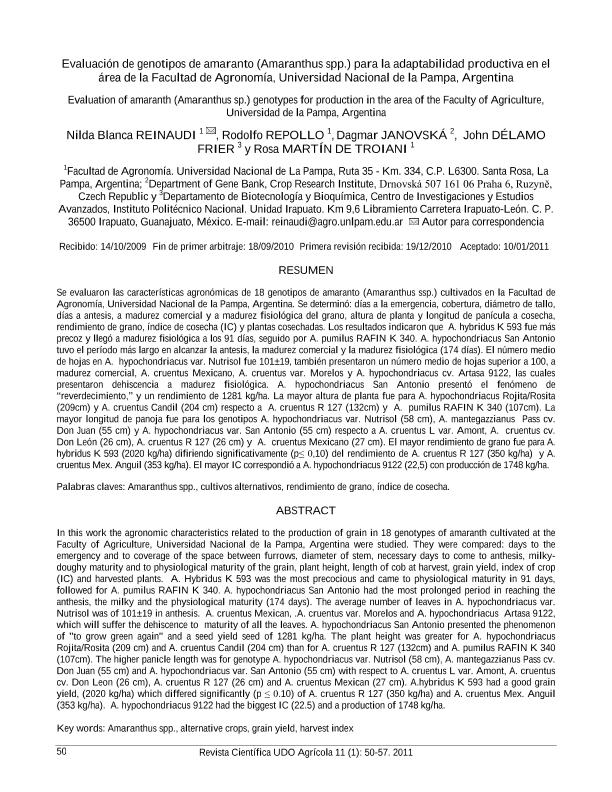Artículo
Se evaluaron las características agronómicas de 18 genotipos de amaranto (Amaranthus ssp.) cultivados en la Facultad de Agronomía, Universidad Nacional de la Pampa, Argentina. Se determinó: días a la emergencia, cobertura, diámetro de tallo, días a antesis, a madurez comercial y a madurez fisiológica del grano, altura de planta y longitud de panícula a cosecha, rendimiento de grano, índice de cosecha (IC) y plantas cosechadas. Los resultados indicaron que A. hybridus K 593 fue más precoz y llegó a madurez fisiológica a los 91 días, seguido por A. pumilus RAFIN K 340. A. hypochondriacus San Antonio tuvo el período más largo en alcanzar la antesis, la madurez comercial y la madurez fisiológica (174 días). El número medio de hojas en A. hypochondriacus var. Nutrisol fue 101±19, también presentaron un número medio de hojas superior a 100, a madurez comercial, A. cruentus Mexicano, A. cruentus var. Morelos y A. hypochondriacus cv. Artasa 9122, las cuales presentaron dehiscencia a madurez fisiológica. A. hypochondriacus San Antonio presentó el fenómeno de ?reverdecimiento,? y un rendimiento de 1281 kg/ha. La mayor altura de planta fue para A. hypochondriacus Rojita/Rosita (209cm) y A. cruentus Candil (204 cm) respecto a A. cruentus R 127 (132cm) y A. pumilus RAFIN K 340 (107cm). La mayor longitud de panoja fue para los genotipos A. hypochondriacus var. Nutrisol (58 cm), A. mantegazzianus Pass cv. Don Juan (55 cm) y A. hypochondriacus var. San Antonio (55 cm) respecto a A. cruentus L var. Amont, A. cruentus cv. Don León (26 cm), A. cruentus R 127 (26 cm) y A. cruentus Mexicano (27 cm). El mayor rendimiento de grano fue para A.hybridus K 593 (2020 kg/ha) difiriendo significativamente (p≤ 0,10) del rendimiento de A. cruentus R 127 (350 kg/ha) y A. cruentus Mex. Anguil (353 kg/ha). El mayor IC correspondió a A. hypochondriacus 9122 (22,5) con producción de 1748 kg/ha. In this work the agronomic characteristics related to the production of grain in 18 genotypes of amaranth cultivated at the Faculty of Agriculture, Universidad Nacional de la Pampa, Argentina were studied. They were compared: days to the emergency and to coverage of the space between furrows, diameter of stem, necessary days to come to anthesis, milkydoughy maturity and to physiological maturity of the grain, plant height, length of cob at harvest, grain yield, index of crop (IC) and harvested plants. A. Hybridus K 593 was the most precocious and came to physiological maturity in 91 days, followed for A. pumilus RAFIN K 340. A. hypochondriacus San Antonio had the most prolonged period in reaching the anthesis, the milky and the physiological maturity (174 days). The average number of leaves in A. hypochondriacus var. Nutrisol was of 101±19 in anthesis. A. cruentus Mexican, .A. cruentus var. Morelos and A. hypochondriacus Artasa 9122, which will suffer the dehiscence to maturity of all the leaves. A. hypochondriacus San Antonio presented the phenomenon of "to grow green again" and a seed yield seed of 1281 kg/ha. The plant height was greater for A. hypochondriacus Rojita/Rosita (209 cm) and A. cruentus Candil (204 cm) than for A. cruentus R 127 (132cm) and A. pumilus RAFIN K 340 (107cm). The higher panicle length was for genotype A. hypochondriacus var. Nutrisol (58 cm), A. mantegazzianus Pass cv. Don Juan (55 cm) and A. hypochondriacus var. San Antonio (55 cm) with respect to A. cruentus L var. Amont, A. cruentus cv. Don Leon (26 cm), A. cruentus R 127 (26 cm) and A. cruentus Mexican (27 cm). A.hybridus K 593 had a good grain yield, (2020 kg/ha) which differed significantly (p ≤ 0.10) of A. cruentus R 127 (350 kg/ha) and A. cruentus Mex. Anguil (353 kg/ha). A. hypochondriacus 9122 had the biggest IC (22.5) and a production of 1748 kg/ha.
Evaluación de genotipos de amaranto (Amaranthus spp.) para la adaptabilidad productiva en el área de la Facultad de Agronomía, Universidad Nacional de la Pampa, Argentina
Título:
Evaluation of amaranth (Amaranthus sp.) genotypes for production in the area of the Faculty of Agriculture, Universidad de la Pampa, Argentina
Reinaudi, Nilda Blanca; Repollo, Rodolfo ; Janovska, Dagmar; Delamo Frier, John; Martín de Troiani, Rosa
; Janovska, Dagmar; Delamo Frier, John; Martín de Troiani, Rosa
 ; Janovska, Dagmar; Delamo Frier, John; Martín de Troiani, Rosa
; Janovska, Dagmar; Delamo Frier, John; Martín de Troiani, Rosa
Fecha de publicación:
12/2011
Editorial:
Universidad de Oriente Press
Revista:
Revista Científica UDO Agrícola
ISSN:
1317-9152
Idioma:
Español
Tipo de recurso:
Artículo publicado
Clasificación temática:
Resumen
Archivos asociados
Licencia
Identificadores
Colecciones
Articulos(CERZOS)
Articulos de CENTRO REC.NAT.RENOVABLES DE ZONA SEMIARIDA(I)
Articulos de CENTRO REC.NAT.RENOVABLES DE ZONA SEMIARIDA(I)
Citación
Reinaudi, Nilda Blanca; Repollo, Rodolfo; Janovska, Dagmar; Delamo Frier, John; Martín de Troiani, Rosa; Evaluación de genotipos de amaranto (Amaranthus spp.) para la adaptabilidad productiva en el área de la Facultad de Agronomía, Universidad Nacional de la Pampa, Argentina; Universidad de Oriente Press; Revista Científica UDO Agrícola; 11; 1; 12-2011; 50-57
Compartir



